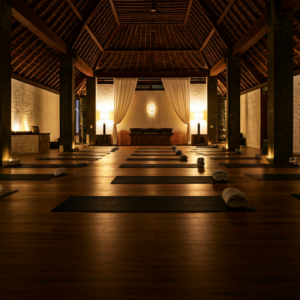In today’s fast-paced world, more people are turning to spiritual guided meditation as a way to find peace, purpose, and connection with their inner selves. The practice has gained significant popularity among those seeking not just relaxation, but a deeper understanding of their spiritual journey and life’s meaning.
As we navigate through life’s challenges, spiritual guided meditation offers a sanctuary where we can explore our consciousness and connect with something greater than ourselves. This ancient practice, combined with modern understanding, provides a structured approach to spiritual growth and self-discovery.
The beauty of spiritual guided meditation lies in its accessibility and profound impact on both beginners and experienced practitioners alike. Whether you’re just starting your spiritual journey or looking to deepen your existing practice, this comprehensive guide will help you understand and embrace this transformative technique.
What is Spiritual Guided Meditation?
Think of spiritual guided meditation as a journey where an experienced guide takes you by the hand through the landscape of your consciousness. Unlike traditional meditation, where you might sit in silence focusing on your breath, this practice involves following verbal instructions that help direct your awareness toward specific spiritual experiences or insights.
This practice typically incorporates:
- Visualization exercises
- Sacred mantras and affirmations
- Energy awareness techniques
- Chakra balancing
- Connection with higher consciousness
- Exploration of spiritual realms
Who Can Benefit from This Practice?
The wonderful thing about meditation is that it’s truly for everyone. You don’t need any special skills or religious beliefs to get started. This practice can benefit:
- Spiritual seekers looking for deeper meaning
- Stressed professionals seeking peace
- Those dealing with emotional challenges
- People exploring their life purpose
- Anyone interested in personal growth
- Individuals from any religious or non-religious background
When to Practice Spiritual Guided Meditation?
The beauty of this practice lies in its flexibility. While many prefer early morning sessions when the mind is fresh and the world is quiet, others find evening practices more suitable. Consider these optimal times:
- Dawn or sunrise (traditionally considered a spiritually powerful time)
- Before important decisions or meetings
- During lunch breaks for mid-day rejuvenation
- Before bedtime for peaceful sleep
- During personal crises or challenging times
- Regular scheduled times to build a consistent practice
Where Should You Practice?
Creating the right environment can significantly enhance your meditation experience. While you can practice anywhere, certain settings are more conducive:
Indoor Spaces:
- A dedicated meditation room
- A quiet corner in your home
- A comfortable chair or cushion
- Near a window with natural light
- In a space with minimal distractions
Outdoor Locations:
- Gardens or parks
- Beach or lakeside
- Forest trails
- Mountain viewpoints
- Quiet natural settings
Why Choose This Practice?
The benefits of regular practice are both immediate and long-term:
Mental Benefits:
- Reduced anxiety and stress
- Improved focus and clarity
- Enhanced emotional stability
- Better decision-making abilities
- Increased creativity and intuition
Physical Benefits:
- Lower blood pressure
- Improved sleep quality
- Reduced chronic pain
- Better immune function
- Decreased muscle tension
Spiritual Benefits:
- Deeper self-awareness
- Enhanced intuitive abilities
- Stronger connection to inner wisdom
- Greater sense of purpose
- Improved relationship with self and others
How to Get Started?
Beginning your journey with meditation doesn’t have to be complicated. Here’s a step-by-step approach:
- Create Your Space
- Choose a quiet, comfortable location
- Gather necessary items (cushion, blanket, timer)
- Consider using soft lighting or candles
- Ensure the temperature is comfortable
- Remove potential distractions
- Choose Your Guide
- Research reputable meditation teachers
- Try different guided recordings
- Consider in-person classes
- Use meditation apps
- Join online meditation communities
- Start Small
- Begin with 5-10 minute sessions
- Gradually increase duration
- Be consistent with practice
- Don’t judge your experience
- Stay patient with yourself
- Basic Techniques
- Focus on breath awareness
- Use body scanning methods
- Practice simple visualizations
- Incorporate gentle movement
- Work with basic mantras
Advanced Practices:
As you progress, you might want to explore:
- Extended meditation sessions
- Silent retreats
- Advanced visualization techniques
- Energy work practices
- Teaching or sharing with others
Common Challenges and Solutions:
- Wandering Mind
- Accept thoughts without judgment
- Gently return to the guide’s voice
- Use anchoring techniques
- Practice patience and persistence
- Remember it’s normal and part of the process
- Physical Discomfort
- Adjust posture as needed
- Use proper supports
- Try different positions
- Take breaks when necessary
- Build up sitting time gradually
- Time Management
- Start with shorter sessions
- Schedule specific times
- Set reminders
- Make it a priority
- Be flexible but consistent
- Maintaining Practice
- Join a meditation group
- Track your progress
- Set realistic goals
- Celebrate small wins
- Keep learning and growing
Integrating Practice into Daily Life:
- Morning Routine
- Start with brief sessions
- Combine with other habits
- Set positive intentions
- Practice mindfulness throughout the day
- Review and adjust as needed
- Throughout the Day
- Take mindful breaks
- Practice while commuting
- Use lunch breaks effectively
- Incorporate mini-meditations
- Stay connected to your breath
- Evening Wind-Down
- Reflect on the day
- Release tension and stress
- Practice gratitude
- Set intentions for sleep
- Connect with inner peace
As we conclude this comprehensive guide, remember that spiritual guided meditation is a journey rather than a destination. It’s a powerful tool for transformation that can help you navigate life’s challenges while deepening your spiritual connection. Whether you’re seeking peace, purpose, or profound spiritual experiences, this practice offers a path to greater awareness and understanding.
Keep in mind that everyone’s journey is unique, and what works for one person might not work for another. Trust your intuition, be patient with yourself, and allow your practice to evolve naturally. The key is to maintain consistency and approach your practice with an open heart and mind.






